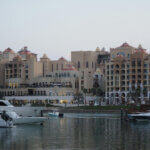
Salvacion Espineda
Business Development Manager
J Estate
Qatar’s roadmap for future development, defines the long-term outcomes for the country rather than the processes for reaching these outcomes. It provides a framework within which national strategies and implementation plans can be developed. The National Vision aims at transforming Qatar into an advanced country by 2030, capable of sustaining its own development and providing for a high standard of living for all its people for generations to come. Throughout QNV 2030, the importance of building a sustainable and environmentally responsible country is evidenced throughout the four core pillars of the vision.
The State of Qatar foresees development through four interconnected pillars: human development, social development, economic development, and environmental development. The environmental pillar will be increasingly important as Qatar is forced to deal with local environmental issues, such as the impact of diminishing water and hydrocarbon resources, and the effects of pollution and environmental degradation, as well as international environmental issues such as the potential impact of global warming on water levels in Qatar and thereby on coastal urban development.
Assessing the severity of risks and dealing with anticipated changes will require mobilising capacities and coordinating efforts to tackle problems that arise. The State of Qatar’s National Vision has implemented many programs and projects to curb air pollutants, reduce Co2 emissions and increase reliance on renewable energy.
The state of Qatar aims to achieve this through the following four pillars:
1. Human development of all Qatar’s people to enable them to sustain a prosperous society.
2. Social development of a just and caring society based on high moral standards, and capable of playing a significant role in the global partnership for development.
3. Economic development of a competitive and diversified economy capable of meeting the needs of, and securing a high standard of living, for all its people.
4. Environmental development Management of the environment such that there is harmony between economic growth, social development, and environmental protection.
5. There has been a growing emphasis in Qatar (along with recent global commitments to net-zero emissions) to tackle climate change and address Environmental, Social and Governance (ESG) concerns. This shift in focus benefits Qatar because of the importance of LNG as a lower-carbon transition fuel to replace coal as an energy source. In October 2021, Qatar released its Climate Change Strategy (CCS), which is focused on adaptation and mitigation, urban planning and development, and spatial land use.
There will be some business opportunities in the following areas:
1. Air Quality – The government is trying to improve the country’s air quality, maintain the quality of the seawater and preserve biodiversity, in addition to chemical and radiological safety and security. The long-term plan is to “become a society completely free of landfills.”
2. Urban Beautification – The government is also aiming at the “beautification of cities and increasing green spaces to promote sustainable urban health.” There are plans for improving the level and quality of green spaces and increasing green areas.
3. Sustainability – The government is seeking better ways to manage natural resources, use less energy, and reduce carbon emissions.
This article was published as part of the eighth edition of Property Finder Qatar’s Trends Report.
You can also search for:
1 bhk for rent in wakra
cheap hotel apartments in doha





